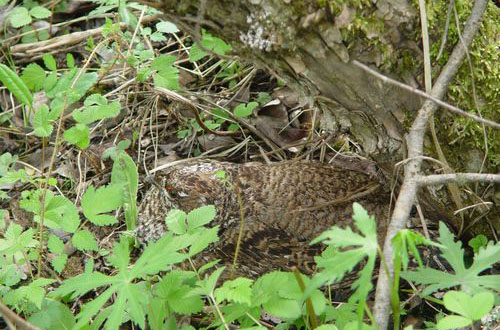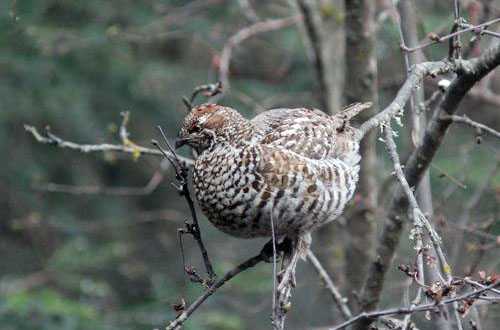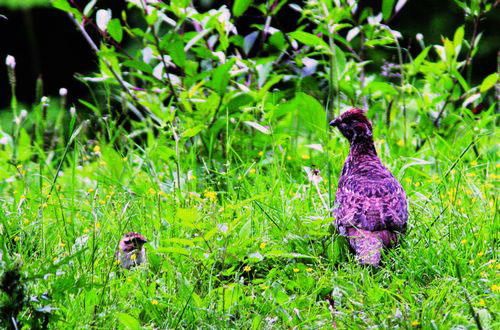The Chinese grouse is considered to be one of the rarest grouse species in the world. In China, it is an endangered species and listed in Category I of nationally protected animals. This bird is an endemic species found in central China, it is the smallest grouse in the world, the most southern grouse in the world, distributed from about 27° to 39° N, and is restricted to a small area of natural mountain forests primarily in the provinces of Gansu, Sichuan, Yunnan, Quinghai, and Tibet. Due to such a secluded and unspectacular lifestyle, it is small wonder that this bird, just the size of a partridge, was not known to science until the end of the 19th century. But even after the first description by Przewalskii (1876), very little was known about the biology of this inconspicuous bird before our studies in Lianhuashan. For example, no surveys were available to assess trends in the number of Chinese grouse. However, it is evident that the species has declined over its limited and fragmented range due to deforestation of its mountain habitats, both in the past as well as more recently.

When sitting at nest, the female Chinese grouse becomes blurred with the environment of the nest site
Our international cooperative research project has resulted in a quantum leap forward in the knowledge of the ecology of Chinese grouse. One major objective of our study was to document important population parameters, such as reproduction and survival, of the Chinese grouse in the apparently good habitat found in this reserve. In addition, we wanted to learn about the species’ use of habitats and its behavior. This base of knowledge would allow us to propose appropriate conservation measures for this species.
The study started in 1995 and was based on the use of radiotelemetry. We captured the grouse, banding them with coloured bands, and equipping them with small necklace transmitters. With the help of the radio transmitters, we were able to locate them daily.
During the winter months, Chinese grouse feed on willow buds on the bushy open mountain slopes. Although the grouse are often found singly or in pairs, during extreme winter conditions they congregate into small groups and feed on buckthorn berries on the open shrublands near timberline.

A female Chinese grouse is feeding on willow buds.
The males return to their territories in the lower coniferous forest at the end of winter. They advertise their position and their occupancy of the territory with a noisy fluttering of their wings.
A male impresses a female by ruffling his plumage to appear as large as possible and by extending his black “beard”. He makes conspicuous jerky movements with his tail and then suddenly fans his tail feathers, showing the tail’s striking black-and-white barred pattern. But when he is in full display, the male raises the completely fanned tail to a nearly vertical position and approaches the female with short steps. Then, seemingly in a stage of excitement, he jumps suddenly towards her and circles her, dragging his lowered wings, and uttering a light, warbling sound. Before mating the male approaches the female in a flat, crouched position, avoiding any appearance of aggressiveness. He then shakes his head from side to side, conspicuously showing his white-framed, black throat. As soon as the hen accepts him, she squats down, facing away from the male, and also starts to shake her head quickly. The male then cautiously mounts the female from the back and they copulate. The male and female maintain a pair bond until the end of the nesting period. During this time, the male will guard his partner. While the female is resting at the base of a bush, at the cluster of arrow bamboo, or is feeding on the forest floor, the male typically hops up onto an exposed stump, shows off by ruffling its plumage, and sits there demonstratively, conspicuous for any rival.
During the first days of May, the females prepare their nesting sites with great secrecy. Camouflage seems to be of greater importance than any complicated construction. It is usually placed in the cover of grasses, at the edge of a small clearing in the forest, in a mossy layer under a slanting trunk of an overhanging tree, or on a narrow terrace of soil on a steep, forested slope. The eggs of Chinese grouse are excellently camouflaged, with a pale brownish colour and darker spots of variable size. The mean clutch size is six eggs. All of the brooding is performed by the female only, although the male can often be observed near the nest site, providing vigilance for his mate and their eggs. The 27-29 days of incubation are especially critical for the parents, because many egg predators are active in the forest in spring, such as jays, stoats, martens or even man. The main predators are mammals that are active in the evening or night. An inattentive yak may also trample the eggs.
Incubation requires a full four weeks, and the downy chicks hatch at the end of June or beginning of July. After the chicks hatch, the family leaves the nest and never returns to it. The chicks are dependent on warmth from the mother for another four to five weeks. She warms them under her breast feathers, similar to a hen. When foraging, the vivacious chicks search in small forest openings for insects. They provide the protein necessary for their rapid growth during their first weeks of life. They quickly climb over roots and tumble over stones and may stop for a sand bath in the warm soil at a sunny forest edge. However, because their small bodies cool after a few minutes, the chicks must frequently return to the brooding mother. While leading the family during such excursions, the mother keeps vocal contact with her chicks.

The brood normally lives with the hen for about three months.
After leaving their roosting trees in the early morning, the grouse start their day with intensive feeding in willows or fruiting mountain ash (Sorbus koehniana), whose beautiful white berries are a much preferred food in autumn. Sometimes conflicts started when feeding males came too close to each other. Like in the hazel grouse, territorial behavior in the Chinese grouse is most intense in spring and autumn.

The clutch size of the Chinese grouse is between 5 and 8 eggs, 6 in the mean
Autumn territoriality decreases when the males leave their territories, to join winter flocks. After the broods break up, the females also move 0.2-5.0 km to wintering areas, where they also join flocks.
From our comparisons of behavior and vocalizations of the Chinese grouse with its most closely related species, the hazel grouse (Bonasa bonasia) of Eurasia and the ruffed grouse (Bonasa umbellus) of Northern America, we win insights of the evolution of the grouse family. Therefore research about its biology should be continued in the future.
